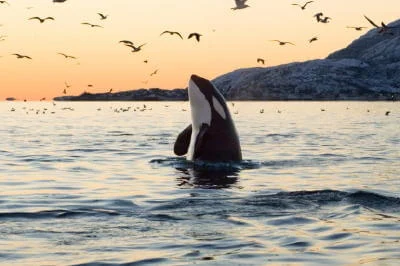Unknown to most whale watchers and kayak tour participants, killer whales in the San Juan Islands occur in two very different species. The two orca whale species in Washington are currently known as “Resident Killer Whales” and “Transient Killer Whales” until better names are decided on. Both species of orca whales in the San Juans apparently live throughout the world but more study is needed to confirm this.
Here are the main differences:
Resident Orca Whales – Live in large matriarchal pods of up to 50 whales, feed almost exclusively on fish, males are about 1 to 2 meters shorter, are very talkative, and relaxed in the presence of kayak tours and whale watchers.

Transient Killer Whales – Live alone or in small pods of less than 10 whales, feed mostly on marine mammals such as seals and sea lions, adults are about 1 to 2 meters longer with taller/sharper dorsal fins, and are much quieter (perhaps because their prey is so intelligent). This is the orca that people think of when they hear the words “killer whale” as they are the largest killers of warm-blooded prey in the world!
Genetic studies confirm that the two species of orca whales do not interbreed and some scientists say they have been separated for 100,000 years. The “transient killer whales” in the San Juan Islands are apparently more closely related to transients in the Atlantic Ocean than they are to the their close neighbors in the Pacific Ocean and Washington.
For these two species of killer whales to share the same waters without socializing or interbreeding despite their superficial similarities speaks to how intensely different their cultures are. Besides having different hunting techniques and family structures, the two orca whale species have different vocalizations. Perhaps this is what keeps them apart more than any other factor. When passing each other in the San Juan Islands, the two killer whale species usually move to opposite sides of the waterway.
Although these facts have been well known for many years, many scientists resist officially recognizing separate killer whale species in the San Juan Islands, or elsewhere around the world where these differences have been noted. While the debate rages, both will share the scientific name of Orcinus orca.
